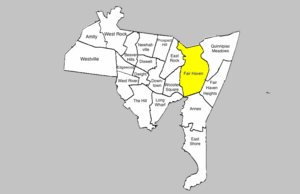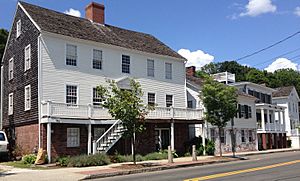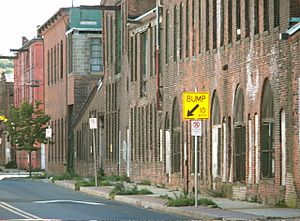Fair Haven, New Haven facts for kids
Quick facts for kids
Fair Haven
|
|
|---|---|
|
Neighborhood of New Haven
|
|

View of the Quinnipiac Brewery from the Ferry Street Bridge
|
|

Fair Haven within New Haven
|
|
| Country | United States |
| State | Connecticut |
| City | New Haven |
Fair Haven is a neighborhood in the eastern part of New Haven, Connecticut. It sits between two rivers, the Mill River and the Quinnipiac River. A small part of the neighborhood is also known as Chatham Square.
Fair Haven is about two miles east of the New Haven Green. It includes several areas of New Haven. The Quinnipiac River forms its eastern and southern borders. The Mill River is to its west, and Amtrak railroad tracks are to the northwest. I-91 (near Exit 7) is to the north. The main roads in the area are Grand Avenue, Blatchley Avenue, and Ferry Street.
In its early days, this area had many different names. Some of these were Farmes, East Farmes, The Neck, Dragon, and Clamtown. A person named Herman Hotchkiss is often called the founder. This is because he invested money and helped develop the area. Fair Haven is a separate neighborhood from Fair Haven Heights, which is right next to it.
Contents
History of Fair Haven
Early Days: 17th Century
Before European settlers arrived, the Momauguin group of Quinnipiack Native Americans used the land in Fair Haven for farming.
It is said that in 1639, Captain Richard Russell saw the harbor. He was so pleased with the view that he called it a "Fayre Haven." In 1640, the area we now call Fair Haven was named 'The Neck'. Fair Haven started as a village in 1679. It was built to house workers for local industries. The area was rich in oysters and other products from the rivers and nearby harbor. At its busiest, it was said to produce almost 5,000 gallons of oysters every day during the season! Besides oyster businesses, factories and a brewery were also built.
In the beginning, you could only reach Fair Haven by boat, walking, or riding a horse. Over time, dirt roads were built for horse-drawn vehicles.
Growing Up: 18th Century
In 1784, Fair Haven became part of the city of New Haven. The Pardee Family started a ferry service across the Quinnipiac River in 1785. This ferry service stopped in 1791. This was because the Dragon Bridge was built.
Changes and Growth: 19th Century
In 1806, land was given to create the Fair Haven Union Cemetery. By 1808, Fair Haven had about 50 houses. In 1820, the first apartment building for many families was constructed. In 1824, residents decided to change the name of their home from 'Dragon' to 'Fair Haven'.
By 1830, the natural oyster beds had become empty. People started bringing in oysters from other places in 1835. The oyster supply was fully restored by 1900.
In 1837, Fair Haven decided to separate from New Haven's control. Many homes in Fair Haven were used as safe places for enslaved people. This was part of the Underground Railroad, a secret network helping people escape to freedom.
By the time of the Civil War, some streets had been paved. After the war, many new people moved to Fair Haven. These immigrants came from places like Ireland, Germany, Poland, Italy, and Russia. One area with many Irish immigrants was even called 'little Dublin'.
In 1860, local business people planned to build a horsecar line. This line would connect Fair Haven and Westville. In 1866, Samuel L. Blatchley developed Blatchley Avenue. He built homes there that were affordable for local workers. St. Francis Church held its first service in 1867. In 1870, Fair Haven rejoined New Haven. The Ferry Street School opened in 1881. In 1885, Nathaniel Graniss donated land for the First Quinnipiac School. The Lancraft Fife and Drum Corps was formed in 1888. They practiced in Ed Lancraft's Oyster house.
Modern Times: 20th and 21st Centuries
By the 1930s, Fair Haven had more immigrants than people born there. Many Black and Puerto Rican families moved to Fair Haven by the 1960s. The area along the Quinnipiac River was redeveloped.
As part of Mayor Richard C. Lee's city improvement plan, 107 families in Fair Haven had to move in the 1960s. In 1978, a special historic district was created to protect old buildings. In the early 1980s, many buildings on Grand Avenue were fixed up.
In recent years, the waterfront area (Front Street and nearby streets) has been redeveloped. New luxury apartments were built, and the Fair Haven marina was improved. The Quinnipiac Terrace public housing project was replaced with a new village. This new village has both affordable and market-rate homes. Many old oyster houses were also renovated. This part of Fair Haven has attracted a mix of young professionals, students, artists, and families. Other parts of Fair Haven still face challenges like poverty and related issues. In 2010, a large 100 kilowatt windmill was built near Criscuolo Park. You can see it from many parts of New Haven.
Fair Haven's Population Over Time
Here's how the number of people living in Fair Haven has changed over the years:
- 1808 - 150 people (15 families)
- 1837 - 1,000 people
- 1850 - 1,317 people
- 1870 - 5,600 people
- 1930 - 23,960 people
- 1989 - 13,895 people
- 1990 - 14,545 people
- 2000 - 13,753 people (4,724 households)
Animals and Plants of Fair Haven
You can find many small animals in Fair Haven. These include mice, urban frogs, opossums, raccoons, and squirrels. Common birds you might see are blue jays, feral pigeons, robins, and starlings. Along Dover Beach, you might spot tiny creatures like scuds and caddisflies.
Some plants that grow in Fair Haven include the autumn olive, the beach rose, Spartina alterniflora, Rosa virginiana, and the weeping willow.
Places to See in Fair Haven
- A. C. Gilbert Company
- Barnesville Bridge (carries Grand Ave over the Mill River)
- The Bigelow Company
- Clinton Avenue School (built in 1911)
- Erector Square
- Ezekiel Cheever School
- Fair Haven Middle School (built in 1927)
- Fair Haven Union Cemetery
- First Church
- Grace Church
- Grand Avenue Bridge (built in 1896; the 3rd bridge on the site).
- Grapevine Point
- John Rowe's tavern
- King's Hotel
- Lewis Bridge (carries Middletown Ave. across the Quinnipiac River)
- Methodist Episcopal Church (originally a Congregational Church)
- National Folding Box Company (In Cedar Hill (New Haven) once a community of Fair Haven)
- National Pipe Bending Company
- New Haven Brewing Company
- Quinnipiac River Historic District
- Quinnipiac River State Park
- River Street Historic District
- Regan Metal Corporation (began in 1887)
- St. Donato Roman Catholic Church (built in 1915)
- St. Francis Roman Catholic Church
- St. Rose Roman Catholic Church (built in 1908)
- Strong School (built in 1916)
- Tomlinson Bridge (built 1796–98)
- Quinnipiac Brewery




